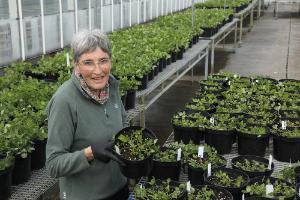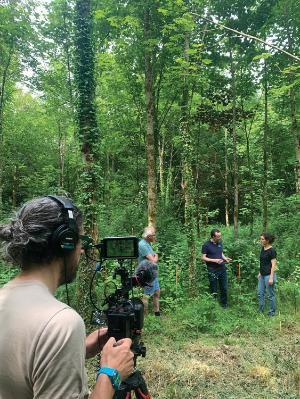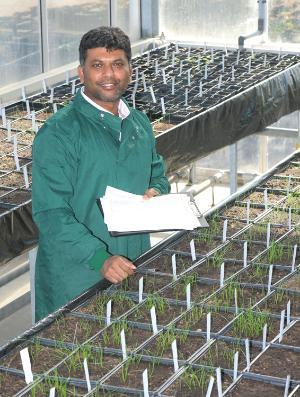New high-yielding white clover varieties
Patrick Conaghan (AGRIP)

The use of white clover on Irish farms has more than tripled over the last three years. Farmers are increasingly using white clover to reduce costs and reliance on chemical nitrogen (N) fertiliser and increase animal output. Hence a need for new, high-yielding and persistent varieties of white clover.
The latest generation of Teagasc white clover varieties was developed from 286 crosses. From these, 25,200 plants were evaluated in 1,260 plots at Oak Park over three years under cutting and sheep grazing. The new varieties have been submitted to the official Recommended List trials in Ireland, England/Wales and Scotland for independent evaluation. Two new large leaf size varieties, named Clodagh and Dungloe, have to date completed the official trials.
Clodagh and Dungloe are the highest-yielding white clover varieties on the Recommended Lists. In Ireland, this equates to over 1t DM/ha more clover than the average Recommended List variety. Large leaf varieties tend to have fewer and shorter stolons than small leaf varieties, resulting in lower ground cover and persistency. Through judicious selection under sheep grazing, Clodagh and Dungloe have been bred to suppress this trend. In the England/Wales Recommended List trials, Clodagh and Dungloe had the highest ground cover of all varieties under cutting or rotational cattle grazing.
Clodagh and Dungloe are among the most productive white clover varieties for farmers in Ireland and UK. The two varieties will be released in spring 2025 by Goldcrop, an Irish seeds and inputs company, that has worldwide propagation and marketing rights on all new varieties. Teagasc and Goldcrop entered into a new long-term forage breeding partnership in 2023, titled ‘Pasture Innovations’.
Clodagh and Dungloe produce over 1t DM/ha more clover than the average variety
Contact: patrick.conaghan@teagasc.ie
Other contributor: Goldcrop Ltd.
Funding: Teagasc and Goldcrop Ltd.
Impact pathway: Technology Development & Adoption.
Further reading: White Clover Trials Test Variety Difference
[photo credit] Karl McDonough
Sustainable Potato Cyst Nematode control through targeted breeding
Dan Milbourne, Denis Griffin, (CELUP)
-300x399.jpg) A cross Europe, over 50% of potato land area is infested with the Potato Cyst Nematode (PCN) species Globodera rostochiensis and Globodera pallida, which dramatically reduce yield and prevent use of the produce for seed. PCN control has become even more difficult since many nematicide products have been withdrawn from the market, creating great demand for resistant varieties.
A cross Europe, over 50% of potato land area is infested with the Potato Cyst Nematode (PCN) species Globodera rostochiensis and Globodera pallida, which dramatically reduce yield and prevent use of the produce for seed. PCN control has become even more difficult since many nematicide products have been withdrawn from the market, creating great demand for resistant varieties.
The Teagasc/IPM Potato Group breeding programme, a collaboration spanning over 60 years, has responded to this demand by developing the variety ‘Buster’, using an approach called Marker Assisted Selection (MAS), which enables the efficient selection for genes conferring resistance to PCN over multiple rapid cycles of breeding. While a single resistance gene confers resistance to G. rostochiensis, multiple partially effective genes are required to control G. pallida.
Buster represents a significant technological achievement; the breeding team used MAS to stack six individual resistance genes in the variety, conferring almost complete resistance to both PCN species.
Since its release in 2019, Buster has undergone multiple, independent trials of its resistance efficacy. These trials show that Buster exhibits the most stable and effective resistance of any variety available by reducing the presence of PCN in the soil to near undetectable levels.
While Buster’s resistance is exceptional, it also delivers excellent yield with low nitrogen input and great flavour. Although in the early stages of commercialisation, Buster is in extremely strong demand from IPM Potato group customers. Varieties such as Buster represent the next step in sustainable agriculture and reduced pesticide and fertiliser use.
Contact: denis.griffin@teagasc.ie
Other contributor: IPM Potato Group.
Funding: IPM Potato Group; Teagasc.
Impact pathways: Capacity Building; Technology Development & Adoption.
[photo credit] Teagasc
Communicating new integrated forest management systems
Jonathan Spazzi, Ian Short (CELUP)

New integrated forest management systems seek to combine the profitable production of quality timber with the enhancement and protection of biodiversity and ecosystem services. To date, lack of knowledge and expertise of management options has been one of the main hurdles to enabling such systems.
Teagasc collaborated with Irish stakeholders and European forest agencies in an Erasmus+ project to develop ‘ForestMoocForChange’ – the first free Massive Open Online Course on the management of continuous cover forestry (CCF). This interactive educational tool aims to facilitate transformation of forests towards integrated management systems, promoting production of quality wood, biodiversity and ecosystem services. The eight-week course is in three languages, self-paced and includes 74 tutorial videos, online quizzes and exercises to carry out in the forest.
During the project, each fortnight a live session allowed participants to ask questions regarding topics covered. On successful completion of quizzes and exercises, participants received a certificate and approved a ‘Charter of Commitment’, to use and further develop their knowledge and understanding of CCF. Over 12,000 learners took the first training course in 2023/2024, with over 2,500 certificates achieved and over 1,000 participants in the English version, co-ordinated by Teagasc.
By demonstrating how forest transformation practices and management tools can be applied, the course provides innovative ways to enhance forest owners’ and managers’ capacity to adopt integrated management systems in their forests and thereby initiate long-term societal change. The course also supports Department of Agriculture, Food and the Marine and European Union forest policies, which increasingly promote integrated management to enhance resilience, sustain production and deliver ecosystem services to society.
Over 2,500 certificates were achieved in 2023/2024
Contact: jonathan.spazzi@teagasc.ie
Other contributors: ANW (Germany); Pro Silva (France); Forêt-Nature (Belgium).
Funding: Erasmus+.
Impact pathways: Technology Development & Adoption; Capacity Building.
[photo credit] Teagasc
Using integrated management to protect cereals
Vijaya Bhaskar A.V., Dermot Forristal, Susanne Barth, Michael Hennessy (CELUP)

Grassweeds such as wild oats, Italian ryegrass and blackgrass are very competitive and can cause yield losses of over 50% in severely infested cereal fields. The rapid evolution of herbicide resistance in these species, and practices that allow their spread, such as early autumn-sowing and increased use of non-plough tillage, makes grassweed control an extreme challenge in Ireland. The first step is identifying the extent of resistance in tillage fields.
Researchers, advisors, growers and stakeholders collaborated in the research project Enable Conservation Tillage (ECT), with the aim of preventing grassweeds becoming an insurmountable challenge that could threaten production viability.
A total of 293 grassweed populations were collected between 2019 and 2022. These were collected from grower’s fields, either as resistance-suspect samples, or as a part of a 2020/2021 survey mapping the distribution of problematic grassweeds. At least 146,500 individual plants were put through a unique comprehensive resistance testing programme to provide feedback to growers.
The ECT research confirmed that extremely aggressive weeds such as blackgrass and Italian ryegrass, that were virtually unknown in Irish crops, are now increasing in occurrence, with 60% of their populations being herbicide-resistant. Overreliance on herbicides has resulted in 26% of wild oat populations becoming resistant.
This research and its dissemination have informed the sector that a radically different approach with less emphasis on herbicides is essential. Developing integrated weed management approaches, including cultural approaches such as rotation and stale seedbeds, is essential. This process has started with advice being provided to farms that submitted samples.
26% of wild oat populations show resistance to herbicide
Contact: vijaya.bhaskar@teagasc.ie
Other contributors: Teagasc crop advisors and participating growers.
Funding: Department of Agriculture, Food, and the Marine.
Impact pathways: Technology Development & Adoption; Capacity Building.
[photo credit] Teagasc
